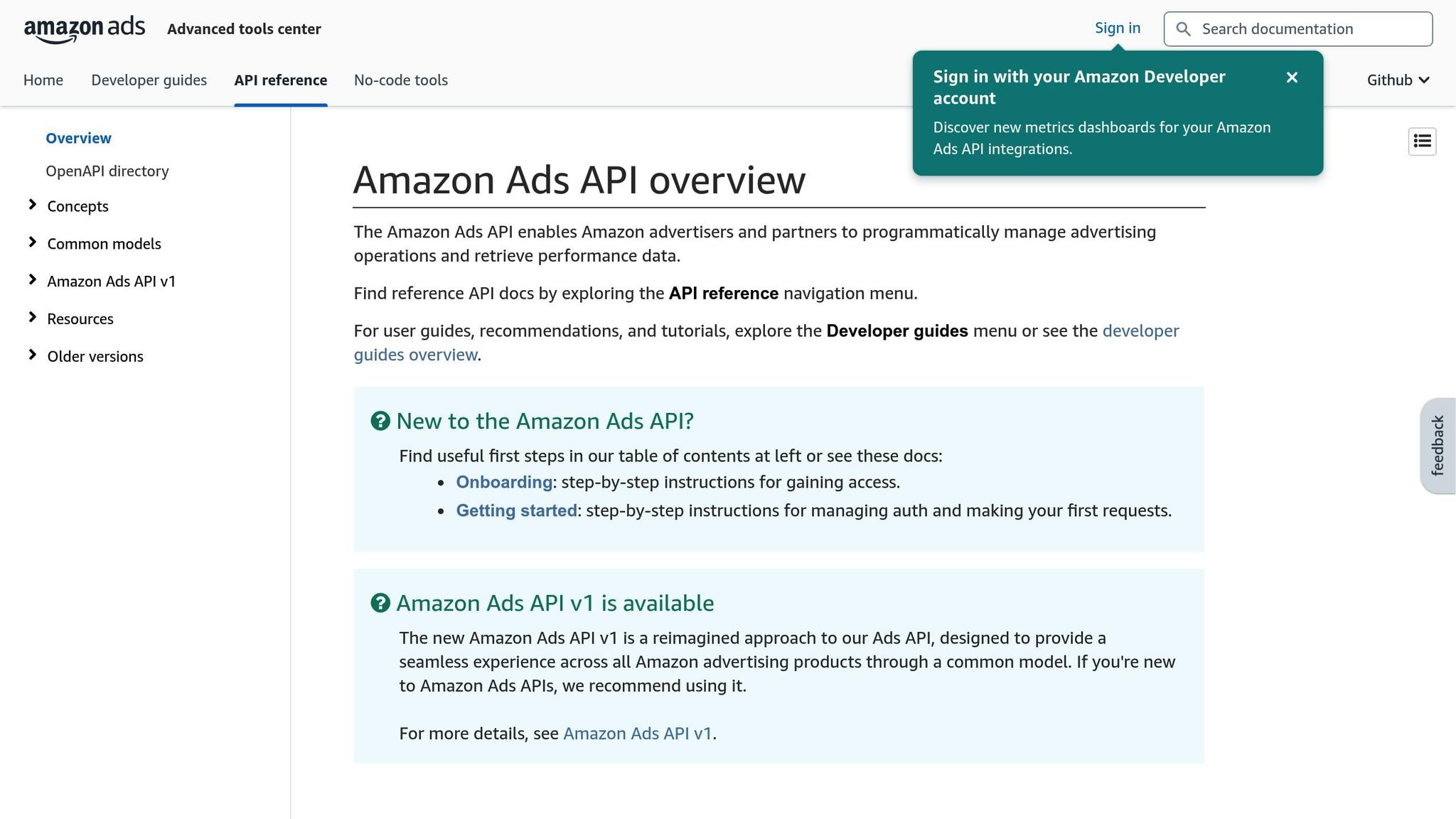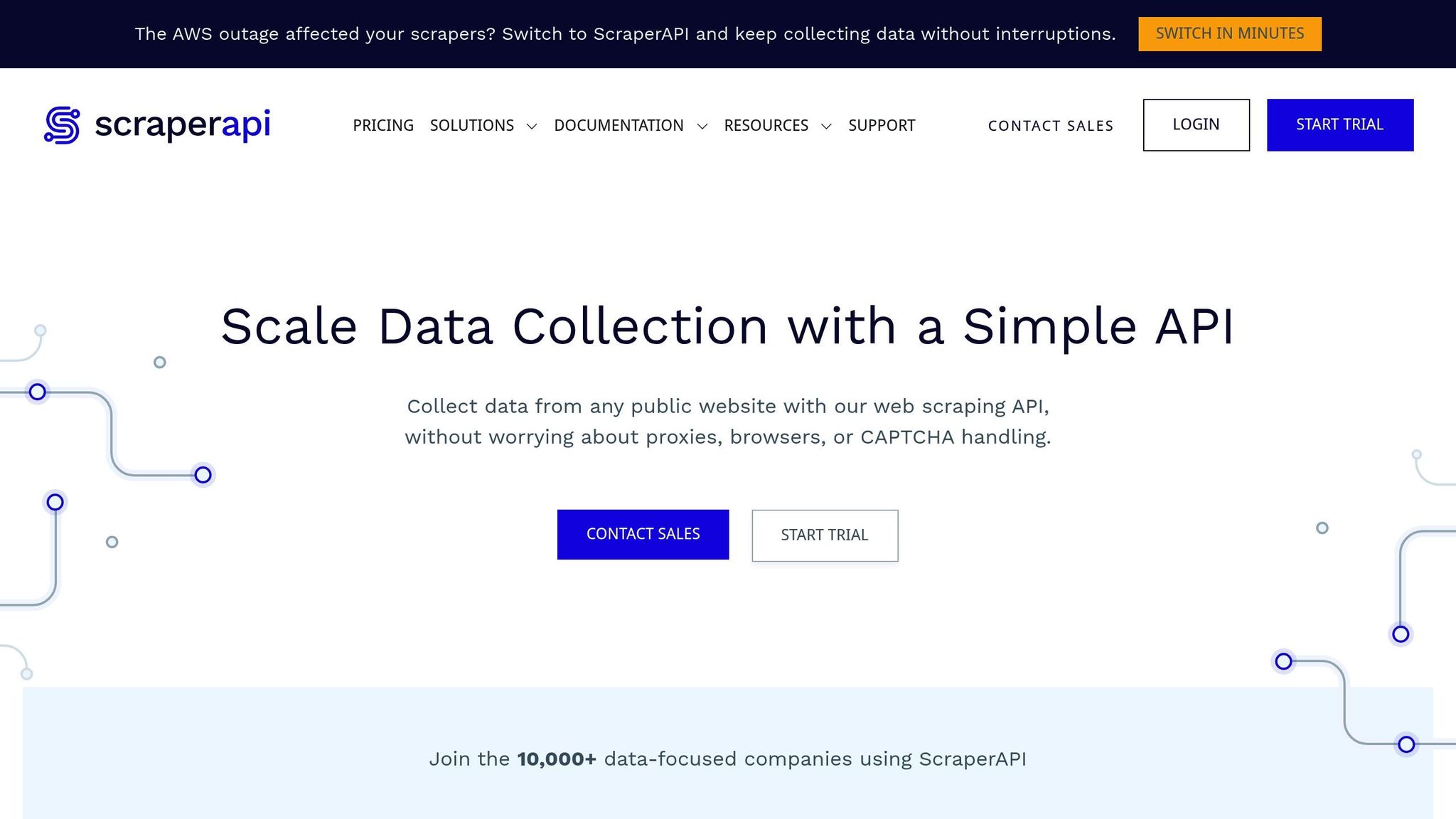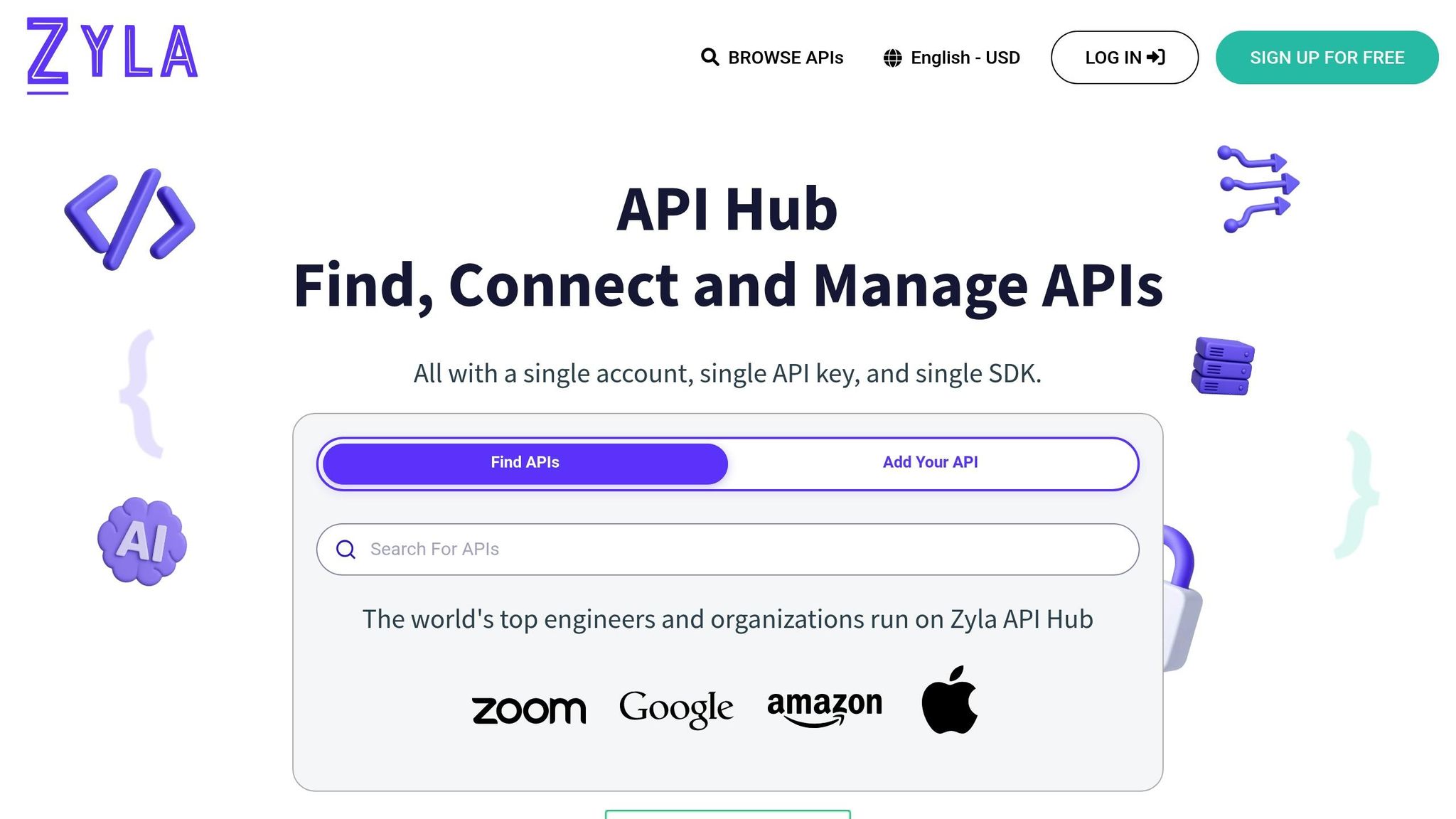7 Best Amazon Data APIs for Small Businesses
Explore essential Amazon data APIs that help small businesses manage inventory, track prices, and analyze competitors efficiently.

7 Best Amazon Data APIs for Small Businesses
Small businesses selling on Amazon face constant challenges like tracking prices, managing inventory, and analyzing competitors. Amazon data APIs help simplify these tasks by automating access to critical marketplace information.
This guide reviews seven APIs tailored for small businesses, covering features, ease of use, and pricing. Whether you need real-time product updates, advertising tools, or inventory management, these APIs can support your business goals.
Quick Overview:
- Canopy API: Real-time data, AI insights, starts free with flexible pricing.
- Amazon Product Advertising API: Free, ideal for affiliate marketers.
- Amazon Selling Partner API (SP-API): Free for sellers, great for order and inventory management.
- Amazon Advertising API: Free API access (ad spend required), automates ad campaigns.
- API Scrapy: Usage-based pricing, offers detailed product and market insights.
- Zyla API Marketplace: Centralized API options with credit-based pricing.
- Bubble Amazon API Integration: No-code platform for connecting Amazon data to custom apps.
Key Takeaways:
- Canopy API offers the most flexibility with real-time updates and AI-driven insights.
- SP-API and Advertising API are free tools for sellers and advertisers.
- API Scrapy provides deeper market insights for competitive analysis.
- For non-developers, Bubble simplifies Amazon API integration without coding.
Choose based on your business needs, technical skills, and budget.
Amazon Marketplace SP API Walkthrough - Orders, Sales and Products requests examples
How to Choose Amazon Data APIs
Picking the right Amazon data API is a critical decision for small businesses, especially in the fast-paced U.S. market. A poor choice can drain resources and leave you lagging behind competitors. Here's what to keep in mind:
Real-Time Data Access and Accuracy
Amazon.com is a marketplace that changes constantly - prices fluctuate, inventory levels shift, and new products are added all the time. To keep up, your API must provide up-to-date data. Look for solutions that offer frequent updates or real-time data access. This ensures you can make timely decisions, whether it's for pricing strategies or inventory management.
Amazon.com Marketplace Support
For businesses in the U.S., it's crucial to have an API that specifically supports Amazon.com. This means access to data like product catalogs, prices, customer reviews, and sales ranks that are directly relevant to American shoppers. Without this, your insights might miss the mark.
Cost Structure and Pricing in USD
Budget is always a factor. APIs often come with various pricing models, including free tiers with limited requests, pay-as-you-go options, or monthly subscriptions. Compare these models to your budget. Calculate how much you’ll pay per data point to find the best value for your investment.
Ease of Integration and Technical Requirements
How easy is it to get the API up and running? Some APIs are plug-and-play with clear documentation (like REST or GraphQL), while others might require advanced coding knowledge. Assess your team’s technical skills and pick an option that aligns with your capabilities to avoid unnecessary headaches during implementation.
Features and Data Coverage
Not all APIs are built the same. Basic ones might only provide product titles and prices, while more advanced options can offer deeper insights like customer reviews, sales estimates, and keyword data. Decide which features are must-haves for your business and which ones are just nice to have.
Scalability and Performance
Your business might start small, but it’s important to think ahead. Will the API handle increased data requests as you grow? Some APIs that work well with a low volume of requests may falter when demand spikes. Look for providers that can scale with your business and offer volume discounts.
Customer Support and Response Times
When issues arise, having reliable support can make a world of difference. Check what kind of support is available - whether it’s through email, live chat, or phone - and whether premium response times are an option. Quick assistance can be crucial when time-sensitive decisions are at stake.
1. Canopy API

The Canopy API is a powerful tool tailored to provide dependable, real-time data from Amazon.com. Designed for small businesses, this API service - compatible with both GraphQL and REST - delivers insights that help fine-tune Amazon strategies with ease.
Real-Time Data Access
With Canopy API, you gain instant updates on Amazon product data, including pricing, sales estimates, and customer reviews. Since prices on Amazon can fluctuate multiple times a day, this real-time functionality ensures you're always in sync with the latest market trends. Combined with a straightforward integration process, the API empowers you to make faster, smarter decisions based on up-to-the-minute information.
Ease of Integration
Integrating Canopy API is designed to be hassle-free, even for small teams. Whether you prefer REST or GraphQL, the API supports both, allowing you to choose the method that aligns with your team's skill set. The service provides comprehensive documentation and open-source examples to make implementation simple. Additionally, built-in AI insights help transform raw data into clear, actionable analysis, making it easier to spot trends and uncover new opportunities.
Feature Set
The Canopy API delivers a wide range of Amazon product data, all accessible through a single interface. From detailed product descriptions and current pricing to customer reviews and sales estimates, the API provides everything you need to analyze the market. It also includes keyword-based search functionality, enabling you to discover new products and identify potential market gaps.
Scalability and Pricing in USD
Canopy API offers flexible pricing plans to accommodate businesses of all sizes:
- Hobby plan: Free, includes 100 requests per month and email support.
- Pay As You Go: Offers 100 free monthly requests, with additional requests priced at $0.01 each. Volume discounts are available.
- Premium plan: Starts at $400 per month for 100,000 requests, with additional requests costing $0.004 each. This plan also includes premium phone support.
Whether you're just starting out or scaling up, Canopy API adapts to your needs, making it a valuable resource for businesses aiming to stay competitive on Amazon.
2. Amazon Product Advertising API

Amazon's Product Advertising API (PA-API) offers free, direct access to Amazon's extensive product catalog. Built with affiliate marketers in mind, its performance-based model is a cost-effective option, especially for small businesses looking to grow.
Ease of Integration
The PA-API is built on REST architecture, which makes it developer-friendly. Amazon provides detailed documentation and Software Development Kits (SDKs) to simplify the setup process. To get started, you’ll need to create an Amazon Associates account to obtain API credentials. These credentials are used with signature-based authentication via REST, making the integration process straightforward. For businesses stepping into affiliate marketing, this accessibility is a big advantage.
Feature Set
The PA-API is tailored for product discovery and affiliate marketing. It allows you to pull detailed information about products, such as titles, descriptions, images, and customer ratings. You can also access Amazon’s pricing data for products linked through affiliate programs.
In addition to product details, the API provides rich metadata like availability status, shipping details, and promotional offers. However, it’s important to note that features like inventory levels or sales estimates are not included. Those capabilities are reserved for APIs designed for Amazon sellers.
Scalability and Pricing
One of the standout aspects of the Amazon Product Advertising API is that it’s completely free - there are no subscription fees or per-call costs. However, access and usage limits depend on your performance as an Amazon Associate. Initial usage limits increase automatically as you generate qualified affiliate sales. To maintain API access, you’ll need to have active sales through your Associates account. This performance-based model makes the PA-API an attractive solution for small businesses working to establish themselves in affiliate marketing.
3. Amazon Selling Partner API (SP-API)

The Amazon Selling Partner API (SP-API) is Amazon's dedicated tool for sellers who need direct access to their marketplace data. Unlike the Product Advertising API, SP-API is tailored specifically for businesses managing their operations on Amazon. It’s particularly useful for small businesses aiming to simplify and optimize their selling processes.
Real-time Data Access
SP-API delivers real-time access to essential data like inventory levels, order updates, and pricing changes. This live connectivity ensures sellers can quickly adapt to market fluctuations, adjust inventory, and streamline fulfillment. Having up-to-the-minute data at your fingertips is a game-changer for staying competitive.
Easy Integration for Developers
SP-API is built on a RESTful architecture and returns data in JSON format, making integration straightforward for developers. Amazon provides detailed documentation and SDKs for popular programming languages, including Java, Python, and JavaScript. Secure access is ensured through LWA tokens and AWS Signature Version 4 authentication.
To get started, sellers need an approved Amazon seller account. The integration process involves registering your application, obtaining credentials, and setting up data permissions - all guided through Amazon's developer console. Even small businesses with limited technical resources can navigate this process with relative ease.
Packed with Features
Once integrated, SP-API offers a wide range of tools designed to support Amazon sellers. These include:
- Order Management: Access full order details, including buyer information, shipping data, and payment specifics.
- Product Catalog Management: Create and update listings, adjust prices, and modify product descriptions.
- Inventory Management: Monitor stock levels, track inbound FBA shipments, and generate inventory health reports.
- Financial Insights: Access settlement reports, transaction details, and fee breakdowns.
- Advertising Tools: Manage sponsored product campaigns and view campaign performance metrics.
- Sales Reporting: Analyze unit sales, revenue, and customer data through business reports like the Detail Page Sales and Traffic report.
These features make it easier for sellers to manage their operations efficiently while gaining valuable insights into their business performance.
Scalability and Cost
SP-API is available to Amazon sellers at no extra charge - there are no subscription fees or per-call costs. While the API does have endpoint-specific rate limits, these are generally sufficient for most small businesses. For those needing higher request volumes, quota increases can be requested via Amazon's developer support.
Whether you’re a small seller or managing a large-scale operation with a vast product catalog, SP-API is designed to grow with your business. It’s a powerful tool for sellers looking to streamline operations and stay ahead in Amazon’s competitive marketplace.
4. Amazon Advertising API

The Amazon Advertising API is a powerful tool designed to help businesses automate and scale their ad campaigns. By focusing on automated campaign management and performance tracking, it allows small businesses to optimize their advertising efforts without requiring constant manual input.
Real-time Data Access
One of the standout features of the Amazon Advertising API is its ability to provide real-time data on campaign performance. It supports Sponsored Products, Sponsored Brands, and Sponsored Display ads, giving businesses the ability to monitor metrics like impressions, clicks, and conversions as they happen. This instant access to data makes it easier to identify underperforming ads and redirect budgets toward campaigns that are delivering better results. The result? Less wasted spend and more efficient use of advertising dollars.
Ease of Integration
Amazon has designed the Advertising API to be accessible, even for businesses with limited technical expertise. Comprehensive documentation is available to guide developers through the integration process, and many smaller businesses partner with external agencies for support.
To make things even easier, Amazon offers test accounts where businesses can experiment with the API's features in a risk-free environment. Ads created in these test accounts don’t appear on Amazon and incur no costs, giving businesses a chance to fine-tune their campaigns before going live. This straightforward setup helps ensure a smooth transition to using the API for active campaigns.
Feature Set
The Amazon Advertising API simplifies campaign management by offering tools for automated bid adjustments, budget optimization, and detailed performance reporting. Businesses can create, modify, and pause campaigns programmatically, while accessing granular data on key metrics like return on ad spend.
For small businesses with tight budgets, the API’s automation capabilities are a game-changer. It allows them to focus resources on high-performing ads and automatically adjust bids based on real-time performance data. This not only reduces unnecessary spending but also opens up opportunities to maximize revenue. The API’s features are designed to streamline daily campaign management while adapting to the evolving needs of growing businesses.
Scalability and Pricing
One of the most appealing aspects of the Amazon Advertising API is its cost structure. Amazon doesn’t charge any additional fees for using the API itself. As stated in their documentation:
"There are no additional fees from Amazon Ads to use the API. The only fees include standard account fees to sell on Amazon, as well as the campaign costs for using Amazon Ads advertising products."
This means businesses only need to consider their advertising spend and any associated infrastructure or analytics costs. The API is also built to scale, allowing businesses to manage multiple brands, campaigns, and ad accounts seamlessly. Whether starting with a small advertising budget or expanding to a more complex strategy, the API ensures efficient and consistent campaign management every step of the way.
sbb-itb-d082ab0
5. API Scrapy Amazon Product API

API Scrapy stands out among Amazon data APIs by combining web scraping techniques with traditional data extraction methods. It's tailored for small businesses looking to gain deeper insights into the market while streamlining their operations. This tool connects directly to Amazon's product data, making it a valuable resource for businesses aiming to stay competitive.
Real-time Data Access
One of API Scrapy's key strengths is its ability to provide real-time product updates. By continuously monitoring Amazon listings, it captures changes in pricing, inventory, and product availability throughout the day. This real-time tracking ensures businesses can react quickly to market fluctuations, whether it's adjusting pricing strategies or managing inventory. The system's fast data processing also helps businesses make timely decisions, keeping them agile in a dynamic marketplace.
Seamless Integration
API Scrapy uses a RESTful architecture, which simplifies the integration process for development teams. It comes with detailed documentation and code examples in popular languages like Python, JavaScript, and PHP, making it adaptable to various technical setups. Additionally, the platform offers pre-built SDKs and step-by-step guides, allowing even teams with limited technical expertise to integrate the API efficiently. This ease of use ensures businesses can quickly start leveraging the platform's features without significant technical hurdles.
Features That Deliver Insights
The API offers access to a wide range of product data, including:
- Pricing history: Analyze trends and seasonal changes in pricing.
- Customer reviews and sentiment analysis: Understand customer satisfaction and feedback to refine marketing or product strategies.
- Seller information and product rankings: Gather details for competitive analysis.
- Inventory tracking: Receive alerts when products go out of stock or when significant market changes occur.
These features are particularly useful for businesses conducting market research or developing competitive strategies. By analyzing historical data and customer sentiment, companies can make informed decisions about product development, pricing, and marketing.
Flexible Scalability and Pricing
API Scrapy uses a usage-based pricing model, making it adaptable for businesses of all sizes. For small businesses just starting with Amazon data integration, the entry-level plan offers a cost-effective way to test strategies and build workflows. As data needs grow, the platform scales seamlessly to handle increased demand, ensuring uninterrupted service. This flexibility makes it a practical choice for businesses looking to expand their data-driven operations over time.
6. Amazon API via Zyla API Marketplace

The Zyla API Marketplace makes it easier for small businesses to access Amazon data by centralizing API options and simplifying how they’re selected and implemented.
Ease of Integration
This platform takes the hassle out of API integration by using a standardized REST architecture paired with consistent, clear documentation. With a unified authentication system, businesses only need to handle one set of API keys, which cuts down on complexity while boosting security. Plus, with webhook integration, users can receive updates in real time.
Feature Set
The APIs available on the marketplace provide access to key Amazon data, including product details, pricing, and inventory status. These tools allow businesses to stay on top of market trends and performance metrics. Some APIs even include filtering options, making it possible to focus on specific categories or segments.
Scalability and Pricing
Zyla Marketplace operates on a credit-based pricing system, offering flexible scaling options with customizable plans. Built-in usage monitoring helps businesses keep costs in check. This streamlined approach also serves as a stepping stone to other integration solutions discussed later in this guide.
7. Bubble Amazon API Integration

Bubble's no-code platform makes it possible for small businesses to connect Amazon data to custom applications without writing a single line of code. With its visual development tools, users can create workflows that integrate Amazon data smoothly, making it a great complement to other API solutions.
Ease of Integration
Bubble's drag-and-drop interface simplifies the process of setting up API connections. Its built-in API connector takes care of complex tasks like authentication and technical configurations, making it easier for users to link their apps to external data sources like Amazon.
Feature Set
With Bubble’s integration tools, businesses can pull key Amazon product details such as titles, descriptions, images, and specifications. This data can then be used to build custom applications that enhance workflows and support better decision-making.
Scalability and Pricing
Bubble provides subscription plans that grow with your business. The platform adjusts to meet application demands, while offering tools to monitor API usage and keep integration costs under control.
API Comparison Table
Choosing the right Amazon data API for your business becomes easier with a side-by-side comparison. This table highlights the key features, pricing, and use cases, making it simpler to align your decision with your specific needs.
| API | Starting Price | Integration Type | Best Use Cases | Key Features |
|---|---|---|---|---|
| Canopy API | Free (100 requests/month) | REST & GraphQL | Product research, competitor analysis, price monitoring | Real-time data, AI-powered insights, sales estimates, detailed product information |
| Amazon Product Advertising API | Free (commission-based) | REST | Affiliate marketing, product recommendations | Official Amazon data, advertising integration, commission tracking |
| Amazon Selling Partner API | Free for sellers | REST | Inventory management, order processing, seller analytics | Direct seller access, order management, inventory tracking |
| Amazon Advertising API | Free (ad spend required) | REST | PPC campaign management, advertising optimization | Campaign automation, bid management, advertising analytics |
The Canopy API provides a free tier with 100 requests per month and a pay-as-you-go model for higher usage, offering flexibility for businesses of all sizes. On the other hand, Amazon's official APIs are free to use but come with specific requirements - such as affiliate credentials for the Product Advertising API or seller registration for the Selling Partner API.
When it comes to integration, Canopy API supports both REST and GraphQL, offering more flexibility compared to Amazon's official APIs, which rely solely on REST. Additionally, Canopy API delivers a more comprehensive dataset, including sales estimates, detailed reviews, and AI-powered insights, making it a versatile option for various business needs. In contrast, Amazon's APIs focus on narrower functions like advertising or seller operations, providing highly specialized and authoritative data.
For businesses looking to scale, Canopy API offers volume discounts, reducing per-request costs as usage grows. This makes it an economical choice for operations that require large data volumes.
Lastly, consider your team's technical expertise when selecting an API. If you have experienced developers, both Canopy API and Amazon's official APIs provide robust customization options, allowing you to tailor the integration to your unique business goals. Carefully evaluate these factors to ensure the API aligns with your priorities and technical capabilities.
Final Thoughts
Choosing the right Amazon data API can make a big difference in how your small business navigates the competitive e-commerce world. The trick is finding an option that fits your current needs, allows for growth, and stays within your budget.
Having access to real-time data is essential in a market that changes constantly. Relying on outdated information can lead to missed opportunities or poor decisions, which could hurt your competitive edge.
Ease of integration is another big factor. If you don’t have a dedicated development team, look for APIs that are simple to set up and come with solid documentation and responsive support. Being honest about your technical resources will help you avoid unnecessary headaches.
As your business grows, managing costs is critical. Many APIs offer volume discounts, which can make scaling more affordable as your data demands increase.
It’s often best to start small and test thoroughly. Many successful small businesses begin by focusing on one or two specific needs - like tracking competitors’ prices or conducting product research - before moving on to more complex uses. This step-by-step approach lets you measure the API’s value and understand its integration process without overloading your team or budget.
FAQs
What should small businesses look for when choosing an Amazon data API?
When choosing an Amazon data API, small businesses should prioritize their unique requirements - whether it's retrieving product details, monitoring price changes, managing inventory, or assessing competitors. It's crucial that the API delivers the needed data in a structured and real-time format while integrating smoothly with your current systems.
You should also evaluate the API's ability to scale alongside your business as it grows and confirm that it adheres to Amazon's terms of service and legal standards. Features like an intuitive interface and dependable customer support can play a key role in streamlining your operations and ensuring efficiency.
How can small businesses use real-time Amazon API data to improve their operations?
Real-time access to Amazon API data gives small businesses a critical edge by delivering up-to-the-minute information on product details, pricing, reviews, and inventory. This allows businesses to make quicker, smarter decisions, like adjusting prices on the fly, managing stock efficiently, and refining product listings to stay competitive.
Having accurate, real-time data at their fingertips helps small businesses simplify key operations. Whether it's tracking inventory, analyzing competitors, or spotting emerging trends, these insights enable businesses to adapt swiftly to market shifts, cut down inefficiencies, and refine their e-commerce strategies for better results.
What costs are involved in using Amazon data APIs for small businesses, and how can these expenses be managed effectively?
The cost of accessing Amazon data APIs for small businesses depends on the specific API and how much it's used. Most of the time, these services operate on a pay-as-you-go model, meaning you're billed based on the number of API calls and the amount of data transferred. There are no upfront fees or long-term contracts, which provides flexibility for businesses.
To keep costs manageable, small businesses can take a few smart steps. For instance, opting for HTTP APIs instead of REST APIs can save money, as they tend to be more budget-friendly. Tools like AWS Service Proxy can also help cut down on integration costs. On top of that, using a content delivery network (CDN) such as Amazon CloudFront can reduce data transfer expenses. Keeping an eye on usage and adjusting based on your business's specific needs can go a long way in controlling expenses.